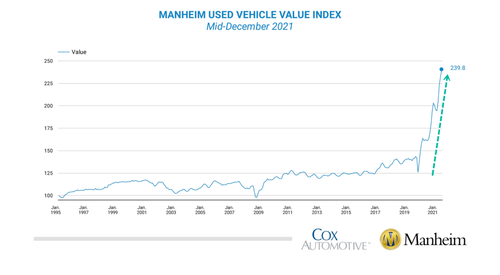Yesterday, after Microsoft stock initially slumped despite beating across the board as the skeptical market latched on to even the smallest weakness to hammer the stock, dragging down both the Nasdaq and S&P futures close to session lows, we said that the reaction was premature and would reverse, as the earnings release did not include guidance and would promptly reverse once the company revealed its cloud guidance in its conference call a little over an hour later. Well, that’s precisely what happened and after first tumbling as much as 5% after hours, the 2nd largest US company (MSFT has $2.2 trillion in market cap) reversed all losses and is now trading solidly in the green, sparking broader tech momentum, lifting the Nasdaq as much as 2.1% this morning and (briefly) helping traders forget that today at 2pm the Fed is expected to unveil a March rate hike and balance sheet runoff a few months later.
Indeed, contracts on the Nasdaq 100 led broad-based gains – which would have been gaping losses had MSFT failed to reverse late on Tuesday – as U.S. stock futures rallied, with investors bracing for the Federal Reserve’s decision and preparing for a slew of earnings from companies including Tesla, Intel and Boeing. Nasdaq 100 futures jumped as much as 2.1% while S&P 500 and Dow Jones futures also rallied. The VIX fell from a one-year high, snapping six days of gains. Elsewhere, the Stoxx Europe 600 rose 2% in the biggest jump in seven weeks. 10Y TSY yields rose to 1.79% with the Fed’s policy announcement in the limelight; the dollar was slightly higher, as was Bitcoin while Brent oil traded just shy of $90 on its way to triple digits.

Of course, the big event today is the Fed policy statement at 2pm ET and press conference 2:30pm, which are expected to ratify expectations for rate increases beginning in March
- Short-term interest rate futures price in just 1bp of rate-hike premium for January meeting but fully price in 25bp for March
- Commentary on shrinking the central bank’s balance sheet is also anticipated
We will have a detailed post on what to expect from the Fed shortly.
“We expect inflation to remain high and interest rates to rise more than investors are expecting today,” said Norbert Frey, head of portfolio management at Fuerst Fugger Privatbank. “A rising interest rate environment is leading to a revaluation of all business models and we think 2022 can be a year of value stocks.”
While equities have had had a rocky start to 2022 as bond yields rose with investors anticipate tighter policy from the Fed, while Russia-U.S. tension added to investor concerns. Now, strategists from Goldman Sachs Group Inc. to Citigroup Inc. are saying it’s time to buy the dip.
“Any further significant weakness at the index level should be seen as a buying opportunity, in our view,” Goldman strategists including Peter Oppenheimer wrote in a note on Wednesday.
In U.S. premarket trading, Microsoft Corp rose, with analysts positive on the software maker’s outlook for growth for its Azure cloud-computing services. Shares gained 4.1% in U.S. premarket trading after initially tumbling before the market heard the company’s strong cloud guidance, with analysts positive on the software maker’s outlook for growth for its Azure cloud-computing services. Analysts also highlighted the company’s commercial bookings and a supportive IT spending backdrop. Texas Instruments shares also rose 4% after the chipmaker gave a first-quarter forecast that was stronger than expected, with analysts noting the company’s conservatism amid a still supportive demand backdrop. Texas Instruments also reported its fourth-quarter results. Other notable premarket movers:
- Cryptocurrency-exposed stocks in Europe and the U.S. are trading higher as Bitcoin kept regaining ground ahead of the Federal Reserve decision. Marathon Digital (MARA US) +6%, (RIOT US) Riot Blockchain +5%, (COIN US) Coinbase +3.4%.
- Electric vehicle stocks climb in U.S. premarket trading ahead of Tesla’s fourth-quarter results due Wednesday after the market close. Rivian (RIVN US) +3.5%; Tesla (TSLA US) +4.4%; Nikola (NKLA US) +3.6%.
- Moderna’s (MRNA US) stock valuation “makes a lot more sense” after more than halving since Deutsche Bank initiated in October, prompting the broker to upgrade the vaccine maker to hold from sell. Shares gain 4.6% premarket.
- Capital One (COF US) reported adjusted earnings per share for the fourth quarter that beat the average analyst estimate. Shares dropped postmarket, with higher expenses “the only wrinkle” in the bank’s quarter, according to Vital Knowledge.
- Stride (LRN US) shares gained 7% postmarket Tuesday after the technology-based education company boosted its revenue forecast for the full year. The guidance beat the average
Global stocks have shed about 7% in January, on track for the worst month since the pandemic roiled markets back in 2020. Some strategists are optimistic about the outlook following the declines.
“The growth-policy trade-off may be less favourable, yet we think a lot of bad news is now priced in,” Emmanuel Cau, head of European equity strategy at Barclays Plc, wrote in a note. “Starts of policy normalisation typically bring higher volatility but rarely terminate bull markets, although higher-than-usual P/E multiples mean equities are more rates-sensitive this time.”
In the latest developments involving Russia and Ukraine, president Joe Biden said he would consider personally sanctioning Vladimir Putin if he orders an invasion of Ukraine, escalating efforts to deter the Russian leader from war. In response, Russian Foreign Minister Sergei Lavrov signaled that Moscow will respond to any “aggressive” action by the U.S. and its European allies as Germany and France pursue efforts to broker a peaceful resolution to the tensions over Ukraine.
European equities rally, brushing off geopolitical tensions, with most indexes clawing back roughly 3/4 of Monday’s sharp sell off to rise over 2%. Europe’s Stoxx 600 adds as much as 2% with travel, energy, miners and autos leading what is broad sectoral support. Here are some of the biggest European movers today:
- Vestas Wind Systems shares rise as much as 6%, reversing an earlier decline, after guidance for 2022 was met with relief. Handelsbanken analysts said the guidance miss was unsurprising, and the market likely feared it would be worse.
- Other European renewables stocks — which have been hit hard in the recent selloff — gain after Vestas’ update, rebounding after declines triggered by Siemens Gamesa’s profit warning last week.
- Travel and leisure is the best-performing sector among Stoxx 600 groups on Wednesday. Airlines including Lufthansa and IAG lead gains, with the German carrier upgraded to buy at Stifel.
- AutoStore advances after being raised to buy at Citi. The upgrade follows a slump of more than 50% amid uncertainty regarding patent litigation and a broader sell-off in tech stocks.
- De Longhi rises as much as 8.9%, the most intraday since March 2021, after Equita upgrades to buy from hold, citing recent underperformance and more confidence in the company’s coffee business.
- Essity falls the most since Oct. 2020 after the Swedish hygiene products manufacturer reported weaker-than-expected earnings and announced further price hikes in 2022.
- Orpea shares continued their descent after its CEO was summoned to the French minister for elderly policy. The French nursing home operator also denied reports it had offered a journalist money to not publish a book critical of the company.
- Barry Callebaut shares fell, reversing earlier gains, after reporting 1Q sales. Citi noted “some more caution” on commodities amid waning supply of cocoa beans.
Earlier in the session, stocks in Asia were mixed after slumping across the board in the previous session, as investors awaited the Federal Reserve’s policy decision. The MSCI Asia Pacific Index was down 0.1%, on track to fall for a fourth day, with advances in communication services and financials offsetting losses in technology shares. Benchmarks in China, Hong Kong and Singapore were among the gainers, while Japan’s Topix Index fell deeper into correction territory. Asian equities have tumbled this month amid heightened volatility on the prospect of U.S. monetary-policy tightening, with the Fed expected to telegraph a March interest-rate hike on Wednesday. Worries over rising rates sent a gauge of the region’s tech hardware stocks to its lowest in months on Wednesday, with chipmakers TSMC and Samsung Electronics among the biggest drags. “There’s a lot of noise in the market right now, and I don’t think anyone’s confident that this is the bottom, because we aren’t sure about Fed policy yet,” said Kyle Rodda, analyst at IG Markets. Despite the broader drop in tech shares, Tencent advanced on dip-buying, helping to boost the Hang Seng Tech Index. The CSI 300 Index whipsawed to narrowly avoid entering a bear market
Fixed income takes a back seat. Curves adopt a modest bear steepening theme with gilts underperforming both bunds and USTs by 1-2bps. Eurodollars bear flatten a touch ahead of today’s FOMC meeting. Peripheral and semi-core spreads narrow with Italy, Belgium and France outperforming.
Treasuries are under pressure in early U.S. trade with U.S. stock index futures higher by 1%-2%, European benchmarks by 2%-3%, with travel, energy, miners and autos leading a broad advance. Front-end yields cheaper by more than 2bp with most curve spreads within 1bp of Tuesday’s close; 10-year yields around 1.785%, outperforming gilts by ~1bp. Focal point of U.S. day is Fed policy decision and Chair Powell news conference. Auction cycle pauses for Fed, concluding with 7-year notes Thursday. The stellar 2Y & 5Y auctions are underwater after stopping through (the 5Y produced record-low dealer award), There is no Fed POMO today. IG dollar issuance slate empty so far and expected to remain slim; Treasury auctions resume with $53b 7-year note sale on Thursday, following strong demand for 2- and 5-year notes earlier this week.
In FX, Bloomberg Dollar Spot is little changed but mixed price action across much of G-10. USD/JPY rises through 114, EUR/USD dips back onto a 1.12-handle. Commodity currencies trade well as crude futures drift back toward Monday’s highs.
Bitcoin extended its gains for the week, trading near $38,000.
In commodities, WTI adds 0.6%, regaining a $86-handle after the latest APIR report showed a draw in U.S. stockpiles and investors tracked tensions over Ukraine for signs the conflict may disrupt supplies. Brent climbs to about $89. Spot gold trades a tight range near $1,846/oz. Most base metals are well bid, lead by LME copper and tin; aluminum underperforms.
Looking at the day ahead now, the main highlight will be the aforementioned Federal Reserve decision and Chair Powell’s subsequent press conference, whilst there’s also a policy decision from the Bank of Canada. On the data side, we’ve got US new home sales for December, along with the preliminary December reading of wholesale inventories. Meanwhile earnings releases include Tesla, Abbott Laboratories, Intel, AT&T and Boeing.
Market Snapshot
- S&P 500 futures up 1.2% to 4,399.50
- STOXX Europe 600 up 1.8% to 467.79
- MXAP down 0.1% to 186.79
- MXAPJ little changed at 612.28
- Nikkei down 0.4% to 27,011.33
- Topix down 0.3% to 1,891.85
- Hang Seng Index up 0.2% to 24,289.90
- Shanghai Composite up 0.7% to 3,455.67
- Sensex up 0.6% to 57,858.15
- Australia S&P/ASX 200 down 2.5% to 6,961.63
- Kospi down 0.4% to 2,709.24
- German 10Y yield little changed at -0.08%
- Euro down 0.2% to $1.1284
- Brent Futures up 0.8% to $88.92/bbl
- Gold spot down 0.1% to $1,846.69
- U.S. Dollar Index up 0.15% to 96.09
Top Overnight News from Bloomberg
- Federal Reserve policy makers are poised to signal plans for their first interest rate hike since 2018 and discuss shrinking their bloated balance sheet as they seek to restrain the hottest inflation in nearly 40 years
- The Treasury market appears more likely to respond in a logical way to Wednesday’s Federal Reserve communications because of indications that the past week’s U.S. stock-market bloodbath cleared out a crowded camp of bets on higher yields
- The employment cost index, which Federal Reserve Chair Jerome Powell cited in December as a key reason for the central bank’s pivot to a more aggressive stance on inflation, is seen registering a fourth-quarter gain nearly on par with the record increase in the prior three months
- Lithuanian Central Bank Governor Gediminas Simkus warned that Europe’s economy would suffer a significant blow if tensions escalate further between Russia and Ukraine, urging politicians to step up efforts to deter hostilities
- OPEC and its allies are expected by delegates to stick to their plan and ratify another modest production increase next week as they try to satisfy rebounding oil demand
A more detailed look at global markets courtesy of Newsquawk
In Asian trading, APAC markets were subdued ahead of the FOMC and holiday-quietened conditions. Nikkei 225 (-0.4%) oscillated around the 27k level after record daily COVID-19 cases. KOSPI (-0.4%) faded opening gains with attention on earnings. Hang Seng (+0.2%) and Shanghai Comp. (+0.7%) were mixed as PBoC liquidity efforts and government support signals were offset as Evergrande default woes resurfaced.
Top Asian News
- Foreigners Cash Out of Key Asian Emerging Markets Before Fed
- China to Start Three-Year Crackdown on Money Laundering
- China Criticizes U.S. Diplomats Seeking Exit Over Covid Rules
- China South City Bonds Rally as Consent Given to Extend 2022s
European bourses are firmer in an extension of yesterday’s upside, with the Stoxx 600 +2.0% on the session but still lower on the week. US futures are firmer across the board with the NQ, +2.0%, outpacing and benefitting from MSFT post earnings, +4.0% in pre-market. European sectors are all in the green with Travel & Leisure outperforming amid broker action while Oil & Gas is a relatively close second given crude action. EU antitrust decision against Intel (INTC) has been annulled in part by the EU General Court. Microsoft (MSFT) Q2 2022 (USD): EPS 2.48 (exp. 2.31), Revenue 51.73bln (exp. 50.88bln). Co. sees Q3 product revenue between USD 15.6bln-15.8bln and expects Azure revenue growth to increase significantly, while it guides Q3 rev. USD 48.5bln-49.3bln (implied) vs exp. USD 47.7bln. +4.0% in the pre-market.
Top European News
- Inflation Outlook No Reason for ECB to Change Track: Simkus
- Italy Asks Firms Not to Meet With Putin Amid Ukraine Crisis
- Finland ‘Wise’ to Sell Long-Maturity Debt Ahead of ECB Tapering
- Europe Travel Stocks Gain on Airlines Boost; Lufthansa Upgraded
In FX, Loonie loving risk recovery and WTI revival in run up to likely BoC hike. Aussie rebounds in absence of those away for a national holiday. Greenback stands firm awaiting something hawkish from the Fed. Kiwi hovering ahead of NZ CPI. -Pound pensive before Partygate findings are published. Rouble unable to benefit from Brent bounce as Russia begins big drills in Black Sea to keep geopolitical tensions elevated.
In commodities, WTI and Brent March futures have continued grinding higher despite quiet news flow as focus remains on geopolitics and the benchmarks also benefit from equity action. At best, WTI and Brent have surpassed USD 86.00/bbl and USD 89.00/bbl respectively thus far. Spot Gold remains contained amid relatively rangebound USD action while Silver is buoyed ahead of USD 24.00 /oz and touted resistance marks. US Private Energy Inventory Data (bbls): Crude -0.9mln (exp. -0.7mln), Gasoline +2.4mln (exp. +2.5mln),
Distillates -2.2mln (exp. -1.3mln), Cushing -1.0mln. Qatar’s Emir is to meet US President Biden on Monday to discuss Afghanistan and contingency plans to supply natural gas to Europe in the event of a Russian invasion of Ukraine. Qatar Emir and US President Biden are to discuss additional Qatari gas supplies to Europe in the case of a Russian-Ukraine conflict at next week’s discussions, via Reuters sources; Qatar has little spare gas for Europe as most gas is pre-sold.
Geopolitics
- US State Department said the US hasn’t seen the de-escalation that is necessary if diplomacy and dialogue with Russia is to prove successful, while US Department of Defense Spokesman Kirby said the US will not rule out adding further troops to the already 8,500 on alert.
- Ukraine Foreign Ministers says the proposals the US will send to Russia do not raise Ukraine’s objections; subsequently, Moscow says received some answers to security guarantee proposals, but not in written form – awaiting further details.
- Ukrainian President Zelensky said the situation in the east is under control and they are working to establish that the meeting of Presidents of Ukraine, Russia, Germany, and France takes place as soon as possible.
- Russian navy has commenced large-scale training in the Black Sea, according to Ifax.
- UK Foreign Minister Truss, when question if they would sanction Russia’s Putin, says they are not ruling anything out.
- Ukraine envoy to Japan said that they are fully committed to a diplomatic solution to the current tensions with Russia, while the envoy also stated that a full-scale war is very difficult to expect although they may see more localised conflict.
US Event Calendar
- 7am: Jan. MBA Mortgage Applications, prior 2.3%
- 8:30am: Dec. Advance Goods Trade Balance, est. -$96b, prior -$97.8b, revised -$98b
- 8:30am: Dec. Retail Inventories MoM, est. 1.5%, prior 2.0%; Wholesale Inventories MoM, est. 1.2%, prior 1.4%
- 10am: Dec. New Home Sales MoM, est. 2.1%, prior 12.4%; New Home Sales, est. 760,000, prior 744,000
- 2pm: FOMC Rate Decision
DB’s Jim Reid concludes the overnight wrap
With markets awaiting today’s policy decision from the Federal Reserve, yesterday marked another volatile session that saw the resumption of the equity selloff as investor jitters remained at the prospect of monetary policy tightening alongside burgeoning geopolitical tensions. Indeed, in many ways it was a repetition of Monday’s session with a further bout of wild intraday swings. At the start, the S&P 500 sold off heavily after the US open to hit an intraday low of -2.79%, with the index back in correction territory. Then it recovered to actually move back into the green for a few minutes, before selling off in the last hour to finish the day down -1.22%, closing -9.18% off its all-time highs reached at the start of the year. With Fed policy so acutely driving risk assets in recent weeks, it sets up an interesting day of communications ahead for the FOMC.
On that front, the Fed are expected to telegraph the start of their latest hiking cycle today, and our US economists write in their preview (link here) that the meeting statement and Chair Powell’s subsequent press conference should confirm that lift-off in the policy rate is likely at the following meeting in March. It comes as the unemployment has now fallen back beneath 4% for the first time since the pandemic began, while CPI in December hit +7.0% year-on-year for the first time since 1982. Our economists’ baseline is for that March hike to be the first of 4 this year, although as they’ve written recently (link here) there is the tail risk of a more aggressive pace still. The market agrees: pricing liftoff for March and 3.96 total hikes through the rest of the year. Balance sheet policy will be of particular focus. Our US econ team believes the Fed will begin QT in Q3. The year-to-date selloff of real rates and equity markets began with the Fed surprising markets by how much they were already considering an early and aggressive use of QT to augment their tightening of policy, so any incremental information will be devoured. While it’s likely too early for the Fed to deliver specific QT details today, our economists believe it’s possible Chair Powell begins to socialise a range of potential QT outcomes to start the give-and-take involved with guiding market expectations. Also of interest will be whether Powell is asked about the possibility of a larger +50bps increase in rates at some point, which had been the topic of some speculation before the latest selloff should the Fed need to tighten financial conditions quickly.
Back to the equity selloff, and there wasn’t a consistent sectoral revival story to tell yesterday, with the volatility sending the VIX higher for a 6th consecutive session to 31.16pts, the longest run of gains in over a year. Tech ended the day as the worst performer, down -2.34%, after rallying in the middle of the session, and the NASDAQ finished the day down -2.28%. Energy (+3.96%) was the key outperformer on the other hand, followed by financials (+0.47%) as the only other sector that managed to finish the day higher. Those moves came as oil rebounded from Monday’s losses, with Brent crude (+2.24%) and WTI (+2.75%) both advancing. After the close we also got earnings from Microsoft, which beat analyst sales and earnings expectations. The stock was slightly higher in after-hours trading on the growth prospects of the company’s cloud computing services. Later today we’ll get Tesla’s earnings and Apple’s tomorrow.
Amidst the equity volatility, sovereign bonds were comparatively subdued again yesterday, with yields on 10yr Treasuries down a paltry -0.2bps to 1.77%. The yield curve managed to flatten, with the 2s10s slope down -4.8bps yesterday to 74.8bps, its lowest closing level in almost a month. This is one of a number of classic late-cycle indicators Jim mentions in the chartbook, and it’s worth noting that on average the 2s10s curve has flattened by around 80bps following the first year of a hiking cycle, so if the Fed does hike in March and the curve follows that historic playbook, we could be looking at an inversion within the next 12-18 months.
Overnight in Asia, equities are putting in a more mixed performance, with the Nikkei (-0.21%), the Kospi (-0.33%) and the Hang Seng (-0.14%) seeing modest falls, whilst the Shanghai Comp is up +0.14%. Futures are pointing to a more positive session in the US and Europe today however, with those on the S&P 50 (+0.20%) and the DAX (+0.49%) both moving higher.
Back in Europe, markets followed a very different playbook yesterday. Having not been open at the time of the late US recovery on Monday, European equities advanced across the board following their rout at the start of the week, and the STOXX 600 rose +0.71%. Meanwhile, with the ECB’s Governing Council not meeting until next week, sovereign bonds also diverged from the US, with yields on 10yr bunds (+2.7bps), OATs (+2.7bps) and gilts (+3.8bps) all moving higher on the day.
With tensions remaining high between Russia and the West over Ukraine, President Biden said in response to a question that the US would consider personal sanctions against President Putin in the event of a Russia invasion. Sanctions against heads of state are an extremely rare step, but the US and others have already threatened severe sanctions if an invasion took place.
On the data side, the Conference Board’s consumer confidence index for January fell a bit less than expected to 113.8 (vs. 112.2 expected). It came as the present situation reading rose to 148.2, but the expectations measure fell to 90.8. Separately in Germany, the Ifo’s business climate indicator in January rose to 95.7 (vs. 94.5 expected), marking the first increase in the indicator after a run of 6 consecutive monthly declines.
Finally, the IMF released their World Economic Outlook update yesterday, in which they downgraded their global growth forecast for 2022 to +4.4% (vs. +4.9% in October). That included cuts to the projections for both the advanced and emerging market economies, with the US and China among those seeing the biggest downgrades. Indeed, the US forecast for this year was cut to +4.0% (vs. +5.2% in October), and China’s was cut to +4.8% (vs. +5.6% in October). One marginal respite was that 2023 did see a modest upgrade, with global growth now projected at +3.8% (vs. +3.6% in October).
To the day ahead now, and the main highlight will be the aforementioned Federal Reserve decision and Chair Powell’s subsequent press conference, whilst there’s also a policy decision from the Bank of Canada. On the data side, we’ve got US new home sales for December, along with the preliminary December reading of wholesale inventories. Meanwhile earnings releases include Tesla, Abbott Laboratories, Intel, AT&T and Boeing.






